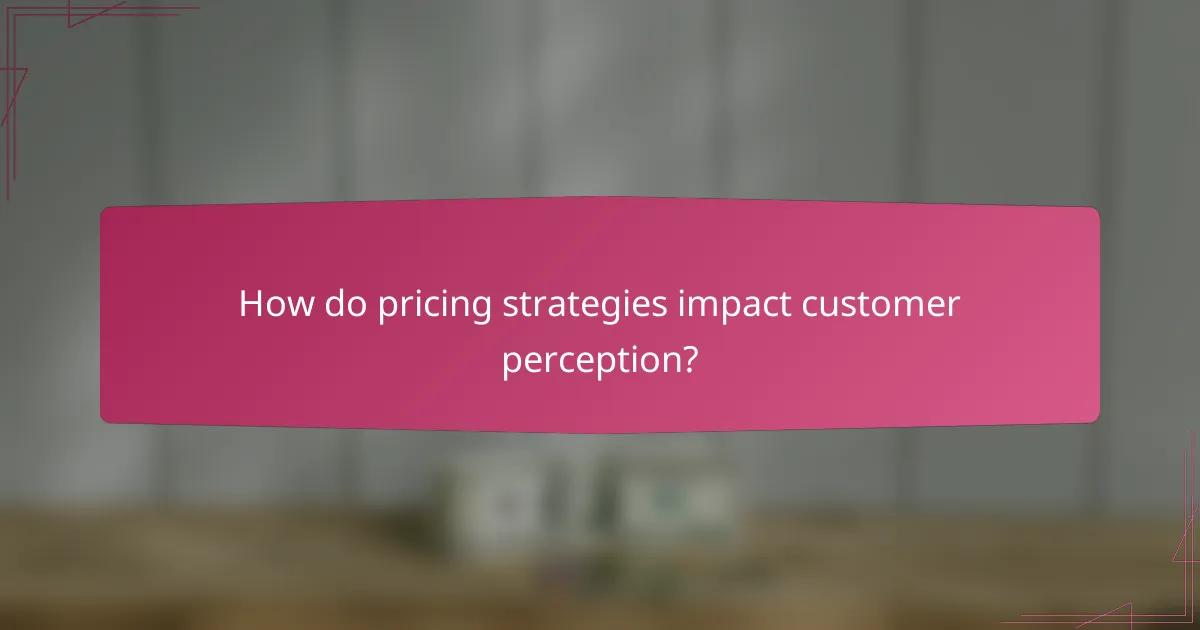In today’s competitive market, effective pricing strategies are crucial for maximizing revenue and ensuring customer satisfaction. By utilizing techniques such as bundling and discounts, businesses can enhance perceived value and encourage larger purchases. Understanding these strategies allows companies to tailor their offerings to meet market demand while appealing to their target audience.

What are effective pricing strategies for digital products?
Effective pricing strategies for digital products focus on aligning the price with perceived value, costs, and market demand. By selecting the right approach, businesses can maximize revenue while ensuring customer satisfaction.
Value-based pricing
Value-based pricing sets prices based on the perceived value to the customer rather than the cost of production. This strategy requires understanding customer needs and the unique benefits your product offers. For example, if a digital tool saves users significant time or money, its price can reflect that value, potentially leading to higher margins.
To implement value-based pricing, conduct market research to gauge customer perceptions and willingness to pay. Avoid underpricing, as it can undermine the perceived quality of your product.
Cost-plus pricing
Cost-plus pricing involves calculating the total cost of production and adding a markup to determine the selling price. This method is straightforward and ensures that all costs are covered while generating profit. For digital products, consider both fixed costs (like software development) and variable costs (like server hosting).
While this approach guarantees cost recovery, it may not always align with market demand. Regularly review costs and market conditions to adjust prices accordingly and avoid losing competitiveness.
Dynamic pricing
Dynamic pricing adjusts prices based on real-time supply and demand conditions. This strategy is common in industries like travel and e-commerce, where prices fluctuate based on factors such as time, competition, and customer behavior. For digital products, consider using algorithms to analyze user data and optimize pricing.
Be cautious with dynamic pricing, as frequent changes can frustrate customers. Establish clear communication about pricing changes and consider implementing a cap to maintain customer trust.
Freemium model
The freemium model offers a basic version of a product for free while charging for premium features. This strategy helps attract a large user base and allows customers to experience the product before committing financially. Examples include software applications that provide essential functionalities at no cost, with advanced features available through subscription or one-time payments.
Ensure that the free version is valuable enough to entice users while clearly differentiating premium features. Monitor conversion rates from free to paid users to assess the effectiveness of this model.
Subscription pricing
Subscription pricing involves charging customers a recurring fee for continuous access to a product or service. This model provides predictable revenue and fosters long-term customer relationships. Digital products such as streaming services and software-as-a-service (SaaS) platforms often utilize this approach.
When setting subscription prices, consider offering tiered plans to cater to different customer segments. Regularly evaluate the value provided to subscribers and adjust pricing or features to retain customers and reduce churn rates.

How can bundles enhance sales?
Bundles can significantly enhance sales by offering customers a perceived value that encourages larger purchases. By grouping products or services together, businesses can increase average transaction sizes and improve customer satisfaction.
Product bundling
Product bundling involves combining multiple products into a single package, often at a discounted price compared to buying each item separately. This strategy not only boosts sales but also simplifies the purchasing decision for customers. For example, a tech retailer might bundle a laptop with a mouse and software, providing a complete solution at a lower total cost.
When implementing product bundling, consider the compatibility of items and the overall value proposition. Aim for bundles that appeal to specific customer needs or use cases, which can lead to higher conversion rates.
Service bundling
Service bundling combines various services into one offering, which can enhance customer loyalty and streamline service delivery. For instance, a telecommunications company might bundle internet, phone, and television services at a competitive rate. This approach can lead to increased customer retention and satisfaction.
To effectively bundle services, ensure that the combined offerings are relevant and provide clear benefits. Monitor customer feedback to refine bundles and adjust pricing strategies as needed to maintain competitiveness.
Cross-selling opportunities
Cross-selling opportunities arise when businesses suggest additional products or services that complement a customer’s initial purchase. This strategy can be particularly effective when combined with bundling, as it encourages customers to consider related items. For example, a customer buying a camera might be offered a bundle that includes lenses and a carrying case.
To maximize cross-selling, train sales staff to identify opportunities and use data analytics to understand customer preferences. Implementing personalized recommendations can significantly enhance the effectiveness of cross-selling efforts.

What types of discounts can be offered?
Discounts can take various forms, each designed to attract customers and boost sales. Understanding the different types of discounts helps businesses implement effective pricing strategies that resonate with their target audience.
Seasonal discounts
Seasonal discounts are price reductions offered during specific times of the year, often aligned with holidays or seasonal events. Retailers frequently use these discounts to clear out inventory or promote seasonal products, such as winter clothing or summer gear.
For example, a store might offer 20-50% off winter apparel during the end of the winter season. Businesses should plan these discounts in advance to maximize their impact and ensure adequate stock levels.
Volume discounts
Volume discounts incentivize customers to purchase larger quantities by providing a lower price per unit. This strategy is common in wholesale and B2B transactions, where buying in bulk can significantly reduce costs.
For instance, a company might offer a 10% discount on orders of 100 units or more. It’s essential to balance the discount level with profit margins to avoid eroding profitability while encouraging larger purchases.
Promotional discounts
Promotional discounts are temporary price reductions aimed at generating excitement or encouraging trial of a product. These discounts can be used for new product launches, special events, or to reward customer loyalty.
Examples include buy-one-get-one-free offers or limited-time discounts of 15-30% off. Businesses should clearly communicate the terms and duration of these promotions to create urgency and drive sales effectively.

What are the criteria for selecting pricing strategies?
Selecting pricing strategies involves evaluating several key criteria that influence how products or services are priced. These criteria include understanding your target audience, assessing market competition, and considering overall business objectives.
Target audience analysis
Understanding your target audience is crucial for effective pricing strategy selection. Analyze demographic factors such as age, income, and purchasing behavior to determine what price points resonate with your customers. For example, a younger audience may be more price-sensitive, while affluent consumers might prioritize quality over cost.
Additionally, consider the perceived value of your product or service to your audience. Conduct surveys or focus groups to gauge how much customers are willing to pay and what features they value most. This insight can help tailor your pricing strategy to meet customer expectations.
Market competition assessment
Assessing market competition is essential for positioning your pricing strategy effectively. Research competitors’ pricing models, including their discounts, bundles, and overall value propositions. This information can help you identify gaps in the market and opportunities for differentiation.
Consider adopting competitive pricing strategies, such as penetration pricing to attract customers or premium pricing to convey exclusivity. Keep in mind that your pricing should reflect not only your costs but also the competitive landscape to ensure you remain attractive to potential buyers.

How do pricing strategies impact customer perception?
Pricing strategies significantly influence how customers perceive a product’s value and the brand itself. Effective pricing can enhance perceived value, attract target demographics, and foster brand loyalty, while poor pricing decisions may lead to negative perceptions and lost sales.
Perceived value
Perceived value refers to the customer’s assessment of a product’s worth based on its price and the benefits it offers. Higher prices can create an impression of superior quality, while lower prices may suggest lower quality. Businesses should consider using pricing strategies like premium pricing or psychological pricing to enhance perceived value.
For example, a luxury brand might set prices significantly above market average to signal exclusivity. Conversely, offering discounts or bundling products can create a perception of value for budget-conscious consumers. Understanding your target market is crucial in determining the right approach.
Brand positioning
Brand positioning is how a brand is perceived in relation to competitors, and pricing plays a vital role in this. A well-defined pricing strategy can help establish a brand’s identity, whether as a budget-friendly option or a high-end luxury choice. Consistency in pricing reinforces brand messaging and helps attract the desired customer segment.
For instance, a brand that positions itself as an affordable option may use competitive pricing and frequent promotions, while a luxury brand might maintain high prices to reinforce its premium image. It’s essential to align pricing strategies with overall brand goals to ensure coherence in customer perception.

What are the emerging trends in digital product pricing?
Emerging trends in digital product pricing focus on personalization, advanced algorithms, and addressing consumer fatigue with subscriptions. These strategies aim to optimize revenue while enhancing customer satisfaction and retention.
Personalized pricing
Personalized pricing tailors prices based on individual customer data, preferences, and behaviors. This approach can significantly improve conversion rates by offering prices that reflect a customer’s willingness to pay.
For example, e-commerce platforms may adjust prices based on browsing history or previous purchases. However, businesses must balance personalization with transparency to avoid customer backlash.
AI-driven pricing models
AI-driven pricing models utilize machine learning algorithms to analyze vast amounts of data, predicting optimal pricing strategies in real-time. These models can adapt to market changes, competitor pricing, and consumer demand.
Companies can implement dynamic pricing, where prices fluctuate based on various factors, such as time of day or inventory levels. While this can maximize profits, it may also lead to customer confusion if not communicated clearly.
Subscription fatigue solutions
Subscription fatigue occurs when consumers feel overwhelmed by numerous subscription services, leading to cancellations. To combat this, companies are exploring bundling options and flexible subscription plans.
Offering bundled services at a discounted rate can provide value and simplify choices for consumers. Additionally, implementing trial periods or pay-as-you-go models can help retain customers by reducing commitment anxiety.
